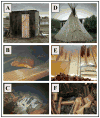Effect of Native American fish smoking methods on dietary exposure to polycyclic aromatic hydrocarbons and possible risks to human health
- PMID: 22690788
- PMCID: PMC3567306
- DOI: 10.1021/jf300978m
Effect of Native American fish smoking methods on dietary exposure to polycyclic aromatic hydrocarbons and possible risks to human health
Abstract
Although it is known that polycyclic aromatic hydrocarbons (PAHs) can be found in smoked meats, little is known about their prevalence in Native American smoked fish. In this work, the effect of traditional Native American fish smoking methods on dietary exposure to PAHs and possible risks to human health has been assessed. Smoking methods considered smoking structure (tipi or shed) and wood type (apple or alder). Neither smoking structure nor wood type accounted for differences in smoked salmon content of 33 PAHs. Carcinogenic and noncarcinogenic PAH loads in traditionally smoked salmon were 40-430 times higher than those measured in commercial products. Dietary exposure to PAHs could result in excess lifetime cancer risks between 1 × 10(-5) and 1 × 10(-4) at a daily consumption rate of 5 g d(-1) and could approach 1 × 10(-2) at 300 g d(-1). Hazard indexes approached 0.005 at 5 g d(-1), or approximately 0.3 at 300 g d(-1). Levels of PAHs present in smoked salmon prepared using traditional Native American methods may pose elevated cancer risks if consumed at high consumption rates over many years.
Figures




References
-
- Harris SG, Harper BL. A Native American exposure scenario. Risk Anal. 1997;17:789–795. - PubMed
-
- Baird WM, Hooven LA, Mahadevan B. Carcinogenic polycyclic aromatic hydrocarbon- DNA adducts and mechanism of action. Environ Mol Mutagen. 2005;45:106–114. - PubMed
-
- Xue W, Warshawsky D. Metabolic activation of polycyclic and heterocyclic aromatic hydrocarbons and DNA damage: A review. Toxicol Appl Pharmacol. 2005;206:73–93. - PubMed
-
- Culp SJ, Gaylor DW, Sheldon WG, Goldstein LS, Beland FA. A comparison of the tumors induced by coal tar and benzo[a]pyrene in a 2-year bioassay. Carcinogenesis. 1998;19:117–124. - PubMed
Publication types
MeSH terms
Substances
Grants and funding
LinkOut - more resources
Full Text Sources

